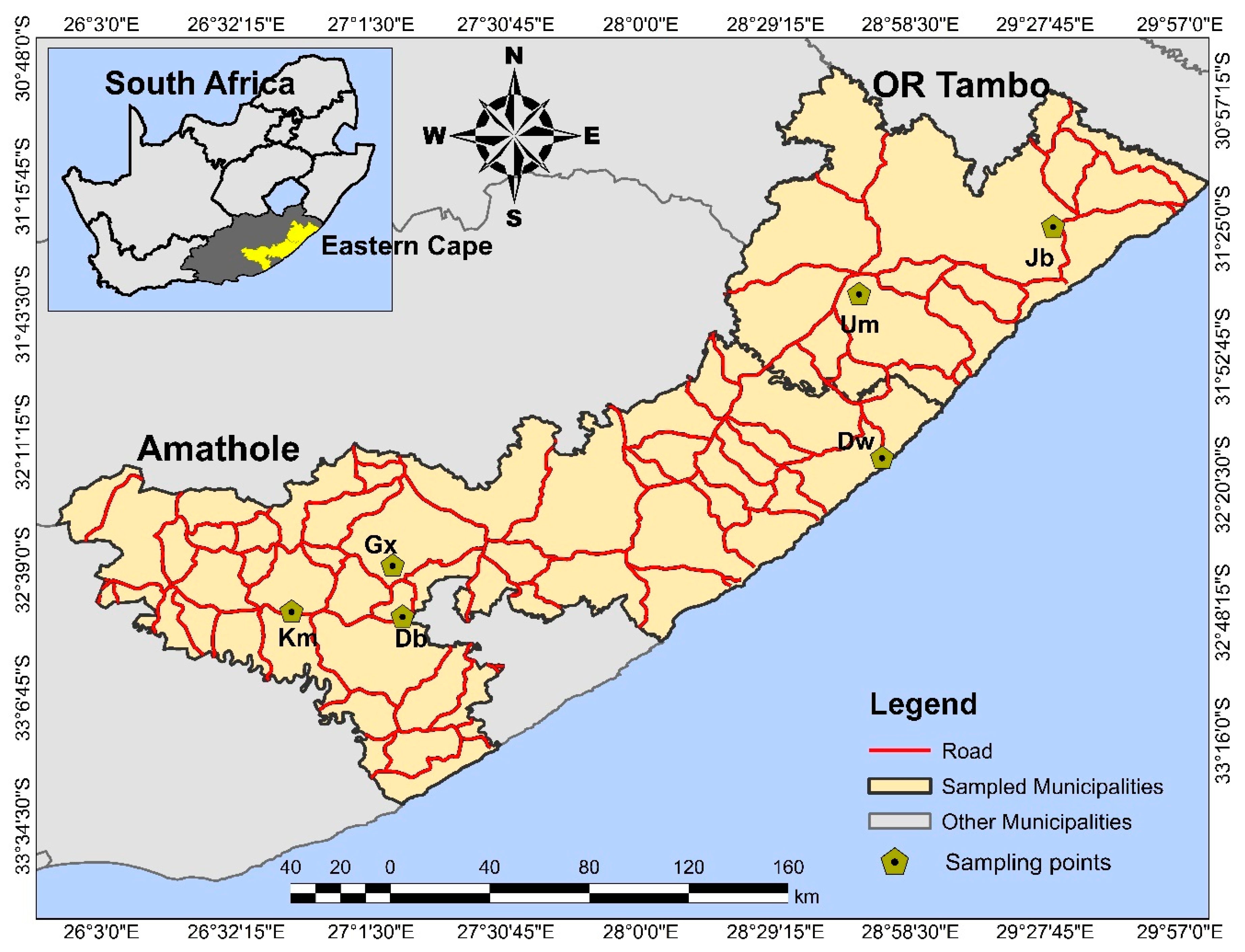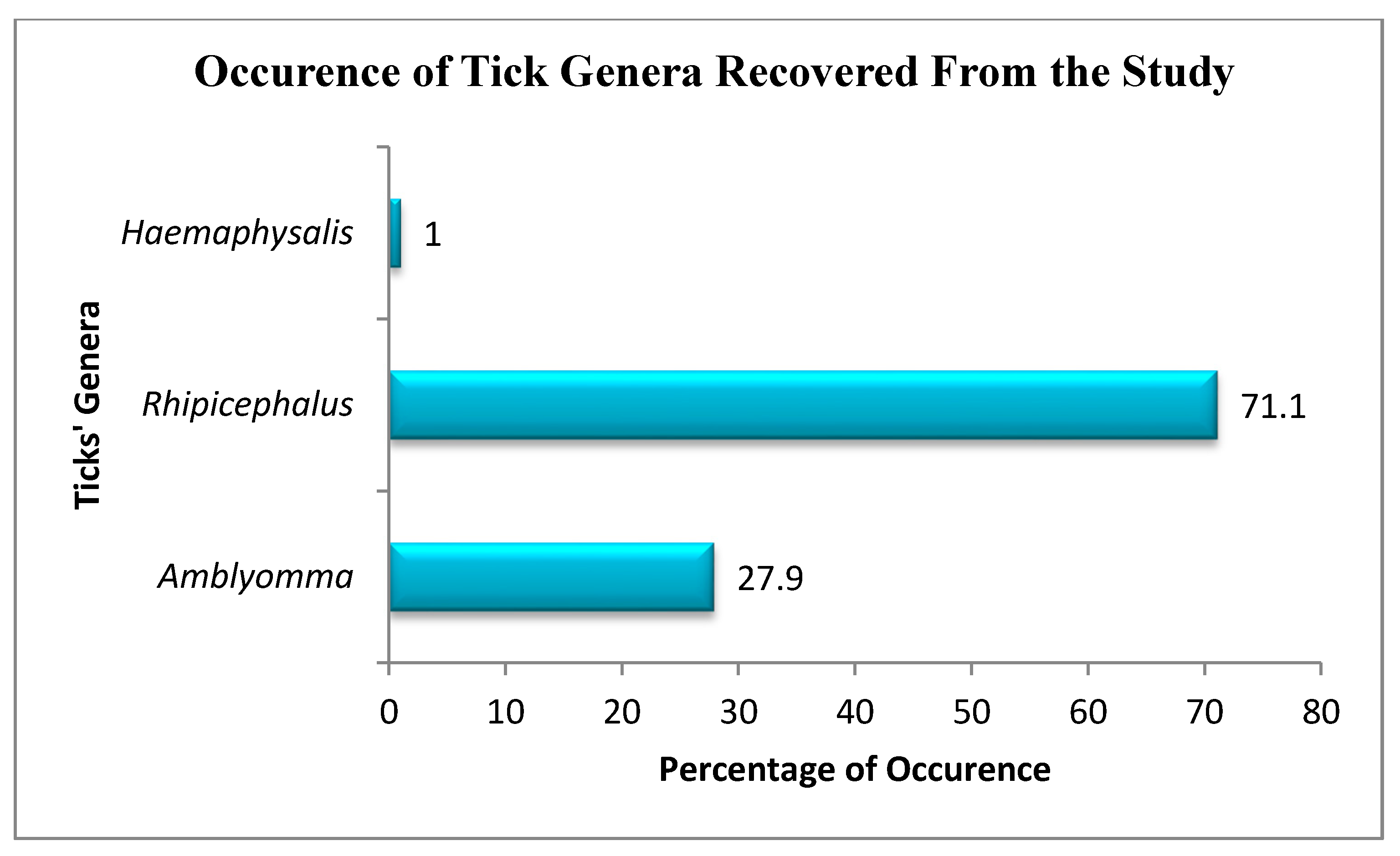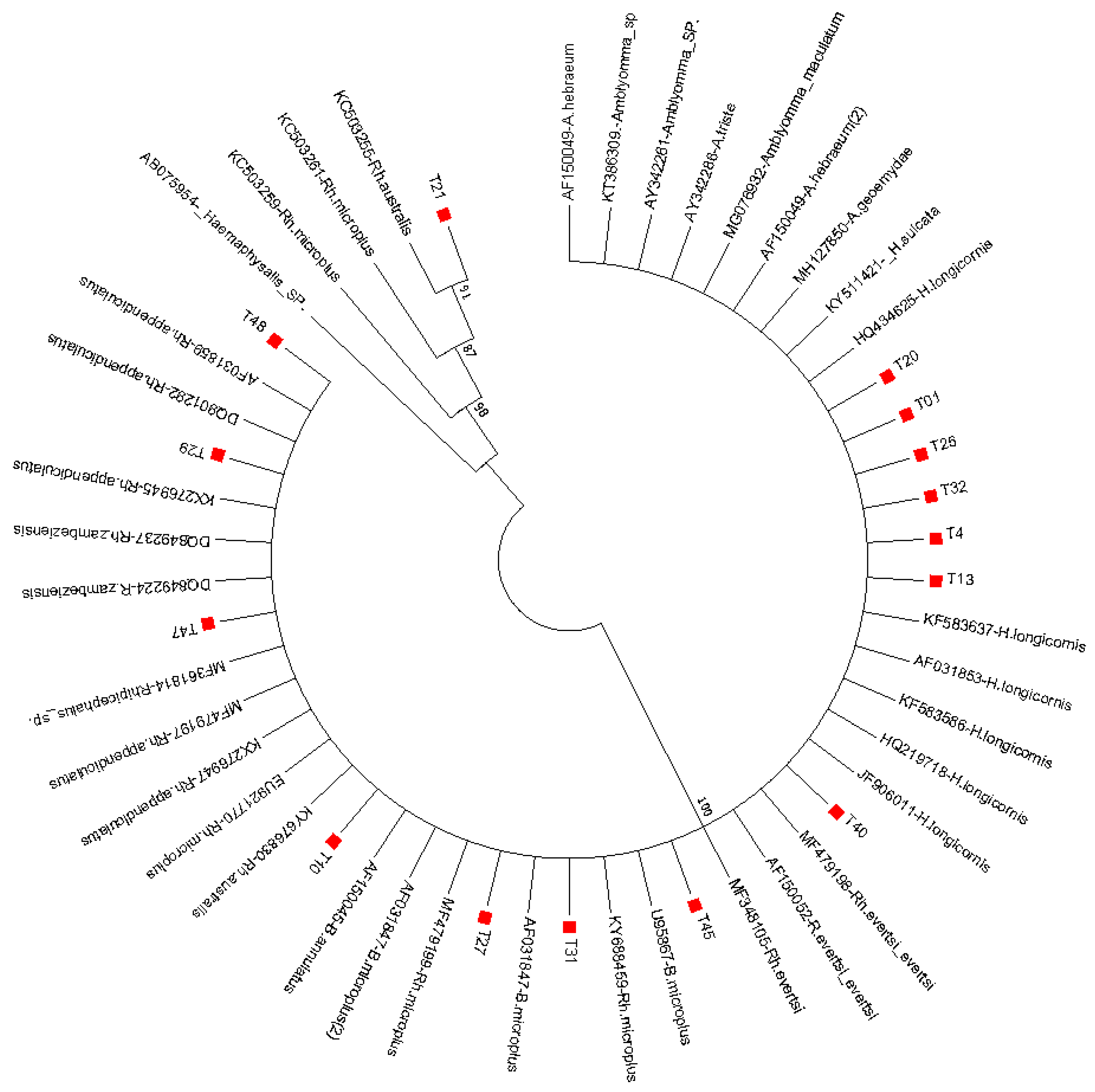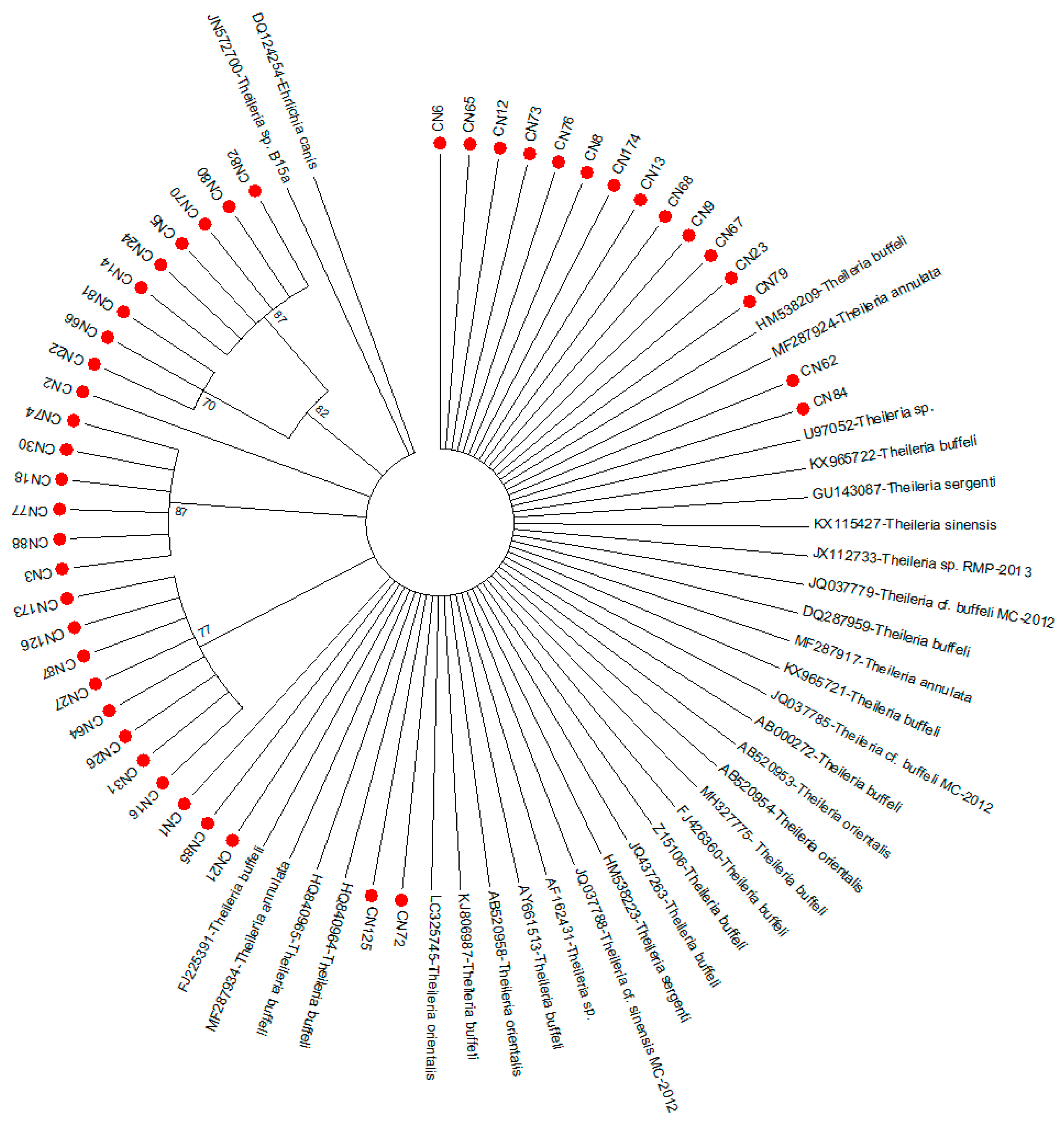Genomic Profiling for Piroplasms in Feeding Ixodid Ticks in the Eastern Cape, South Africa
Abstract
:1. Introduction
2. Materials and Methods
2.1. Sample Collection
2.2. Morphological Identification
2.3. Genomic DNA Extraction
2.4. Molecular Identification of Tick Species
2.5. PCR Amplification of Tick-Borne Protozoan Pathogens
2.6. Sequence Editing and Blast Search
3. Results
3.1. Detection of Piroplasms
3.2. Phylogenetic Analysis of Theileria Pathogen
3.3. Accession Number
4. Discussion
5. Conclusions
Author Contributions
Funding
Acknowledgments
Conflicts of Interest
References
- Gabrielli, S.; Calderini, P.; Cassini, R.; Galuppi, R.; Tampieri, M.P.; Pietrobelli, M.; Cancrini, G. Human exposure to piroplasms in Central and Northern Italy. Vet. Ital. 2014, 50, 41–47. [Google Scholar]
- Hassan, M.A.; Liu, J.; Rashid, M.; Iqbal, N.; Guan, G.; Yin, H.; Luo, J. Molecular survey of piroplasm species from selected areas of China and Pakistan. Parasites Vectors 2018, 11, 457. [Google Scholar] [CrossRef] [Green Version]
- Gebrekidan, H.; Gasser, R.B.; Baneth, G.; Yasur-Landau, D.; Nachum-Biala, Y.; Hailu, A.; Jabbar, A. Molecular characterization of Theileria orientalis from cattle in Ethiopia. Ticks Tick-Borne Dis. 2016, 7, 742–747. [Google Scholar] [CrossRef] [Green Version]
- Peckle, M.; Pires, M.S.; da Silva, C.B.; da Costa, R.L.; Vitari, G.L.V.; Senra, M.V.X.; Dias, R.J.P.; Santos, H.A.; Massard, C.L. Molecular characterization of Theileria equi in horses from the state of Rio de Janeiro, Brazil. Ticks Tick-Borne Dis. 2018, 9, 349–353. [Google Scholar] [CrossRef]
- Sivakumar, T.; Hayashida, K.; Sugimoto, C.; Yokoyama, N. Evolution and genetic diversity of Theileria. Infect. Genet. Evol. 2014, 27, 250–263. [Google Scholar] [CrossRef] [Green Version]
- Nene, V.; Morrison, W.I. Approaches to vaccination against Theileria parva and Theileria annulata. Parasite Immunol. 2016, 38, 724–734. [Google Scholar] [CrossRef] [Green Version]
- Zweygarth, E.; Nijhof, A.M.; Knorr, S.; Ahmed, J.S.; Al-Hosary, A.T.; Obara, I.; Bishop, R.P.; Josemans, A.I.; Clausen, P.H. Serum-free in vitro cultivation of Theileria annulata and Theileria parva schizont-infected lymphocytes. Transbound. Emerg. Dis. 2020, 67, 35–39. [Google Scholar] [CrossRef] [Green Version]
- Abdallah, M.O.; Niu, Q.; Yang, J.; Hassan, M.A.; Yu, P.; Guan, G.; Chen, Z.; Liu, G.; Luo, J.; Yin, H. Identification of 12 piroplasms infecting ten tick species in China using reverse line blot hybridization. J. Parasitol. 2017, 103, 221–227. [Google Scholar] [CrossRef] [Green Version]
- Jabbar, A.; Abbas, T.; Saddiqi, H.A.; Qamar, M.F.; Gasser, R.B. Tick-borne diseases of bovines in Pakistan: Major scope for future research and improved control. Parasites Vectors 2015, 8, 283. [Google Scholar] [CrossRef] [Green Version]
- Schnittger, L.; Rodriguez, A.E.; Florin-Christensen, M.; Morrison, D.A. Babesia: A world emerging. Infect. Genet. Evol. 2012, 12, 1788–1809. [Google Scholar] [CrossRef]
- Chisu, V.; Alberti, A.; Zobba, R.; Foxi, C.; Masala, G. Molecular characterization and phylogenetic analysis of Babesia and Theileria spp. in ticks from domestic and wild hosts in Sardinia. Acta Trop. 2019, 196, 60–65. [Google Scholar] [CrossRef]
- Ord, R.L.; Lobo, C.A. Human babesiosis: Pathogens, prevalence, diagnosis, and treatment. Curr. Clin. Microbiol. Rep. 2015, 2, 173–181. [Google Scholar] [CrossRef]
- Chaisi, M.E.; Sibeko, K.P.; Collins, N.E.; Potgieter, F.T.; Oosthuizen, M.C. Identification of Theileria parva and Theileria sp. (buffalo) 18S rRNA gene sequence variants in the African Buffalo (Syncerus caffer) in southern Africa. Vet. Parasitol. 2011, 182, 150–162. [Google Scholar] [CrossRef] [Green Version]
- Berggoetz, M.; Schmid, M.; Ston, D.; Wyss, V.; Chevillon, C.; Pretorius, A.M.; Gern, L. Tick-borne pathogens in the blood of wild and domestic ungulates in South Africa: Interplay of game and livestock. Ticks Tick-Borne Dis. 2014, 5, 166–175. [Google Scholar] [CrossRef]
- Ringo, A.E.; Moumouni, P.F.A.; Taioe, M.; Jirapattharasate, C.; Liu, M.; Wang, G.; Gao, Y.; Guo, H.; Lee, S.H.; Zheng, W.; et al. Molecular analysis of tick-borne protozoan and rickettsial pathogens in small ruminants from two South African provinces. Parasitol. Int. 2018, 67, 144–149. [Google Scholar] [CrossRef]
- Bhoora, R.V.; Collins, N.E.; Schnittger, L.; Troskie, C.; Marumo, R.; Labuschagne, K.; Smith, R.M.; Dalton, D.L.; Mbizeni, S. Molecular genotyping and epidemiology of equine piroplasmids in South Africa. Ticks Tick-Borne Dis. 2019, 11, 101358. [Google Scholar] [CrossRef]
- Horak, I.G. Parasites of domestic and wild animals in South Africa. XXXVII. Ixodid ticks on cattle on Kikuyu grass pastures and in Valley Bushveld in the Eastern Cape Province. Onderstepoort J. Vet. Res. 1999, 66, 175–184. [Google Scholar]
- Walker, J.B.; Keirans, J.E.; Horak, I.G. The Genus Rhipicephalus (Acari, Ixodidae): A Guide to the Brown Ticks of the World; Cambridge University Press: Cambridge, UK, 2005. [Google Scholar]
- James, M.C.; Gilbert, L.; Bowman, A.S.; Forbes, K.J. The heterogeneity, distribution, and environmental associations of Borrelia burgdorferi sensu lato, the agent of Lyme borreliosis, in Scotland. Front. Public Health 2014, 2, 129. [Google Scholar] [CrossRef]
- Bhoora, R.; Franssen, L.; Oosthuizen, M.C.; Guthrie, A.J.; Zweygarth, E.; Penzhorn, B.L.; Jongejan, F.; Collins, N.E. Sequence heterogeneity in the 18S rRNA gene within Theileria equi and Babesia caballi from horses in South Africa. Vet. Parasitol. 2009, 159, 112–120. [Google Scholar] [CrossRef] [Green Version]
- Lee, P.Y.; Costumbrado, J.; Hsu, C.Y.; Kim, Y.H. Agarose gel electrophoresis for the separation of DNA fragments. J. Vis. Exp. 2012, 3923. [Google Scholar] [CrossRef]
- Kearse, M.; Moir, R.; Wilson, A.; Stones-Havas, S.; Cheung, M.; Sturrock, S.; Buxton, S.; Cooper, A.; Markowitz, S.; Duran, C.; et al. Geneious Basic: An integrated and extendable desktop software platform for the organization and analysis of sequence data. Bioinformatics 2012, 28, 1647–1649. [Google Scholar] [CrossRef]
- Kumar, S.; Stecher, G.; Tamura, K. MEGA7: Molecular evolutionary genetics analysis version 7.0 for bigger datasets. Mol. Biol. Evol. 2016, 33, 1870–1874. [Google Scholar] [CrossRef] [Green Version]
- Saitou, N.; Nei, M. The neighbor-joining method: A new method for reconstructing phylogenetic trees. Mol. Biol. Evol. 1987, 4, 406–425. [Google Scholar]
- Felsenstein, J. Confidence limits on phylogenies: An approach using the bootstrap. Evolution 1985, 39, 783–791. [Google Scholar] [CrossRef]
- Tamura, K.; Nei, M.; Kumar, S. Prospects for inferring very large phylogenies by using the neighbor-joining method. Proc. Natl. Acad. Sci. USA 2004, 101, 11030–11035. [Google Scholar] [CrossRef] [Green Version]
- Nei, M.; Kumar, S. Molecular Evolution and Phylogenetics; Oxford University Press: Oxford, UK, 2000. [Google Scholar]
- Maji, C.; Goel, P.; Suthar, A.; Mandal, K.D.; Gopalakrishnan, A.; Kumar, R.; Kumar, S. Lumefantrine and o-choline–Parasite metabolism specific drug molecules inhibited in vitro growth of Theileria equi and Babesia caballi in MASP culture system. Ticks Tick-Borne Dis. 2019, 10, 568–574. [Google Scholar] [CrossRef]
- Vannier, E.; Krause, P.J. Human babesiosis. N. Engl. J. Med. 2012, 366, 2397–2407. [Google Scholar] [CrossRef] [Green Version]
- Lempereur, L.; Shiels, B.; Heyman, P.; Moreau, E.; Saegerman, C.; Losson, B.; Malandrin, L. A retrospective serological survey on human babesiosis in Belgium. Clin. Microbiol. Infect. 2015, 21, 96.e1–96.e7. [Google Scholar] [CrossRef] [Green Version]
- Peniche-Lara, G.; Balmaceda, L.; Perez-Osorio, C.; Munoz-Zanzi, C. Human Babesiosis, Yucatán State, Mexico. Emerg. Infect. Dis. 2018, 24, 2061. [Google Scholar] [CrossRef] [Green Version]
- Khukhuu, A.; Lan, D.T.B.; Long, P.T.; Ueno, A.; Li, Y.; Luo, Y.; de Macedo, A.C.C.; Matsumoto, K.; Inokuma, H.; Kawazu, S.I.; et al. Molecular epidemiological survey of Theileria orientalis in Thua Thien Hue province, Vietnam. J. Vet. Med Sci. 2011, 73, 701–705. [Google Scholar] [CrossRef] [Green Version]
- Morrison, W.I. The aetiology, pathogenesis and control of theileriosis in domestic animals. Rev. Sci. Tech. 2015, 34, 599–611. [Google Scholar] [CrossRef]
- Dantas-Torres, F.; Otranto, D. Theileriosis. In Arthropod Borne Diseases; Springer: Cham, Switzerland, 2017; pp. 355–361. [Google Scholar]
- Tonetti, N.; Berggoetz, M.; Rühle, C.; Pretorius, A.M.; Gern, L. Ticks and tick-borne pathogens from wildlife in the Free State Province, South Africa. J. Wildl. Dis. 2009, 45, 437–446. [Google Scholar] [CrossRef] [Green Version]
- Molaei, G.; Andreadis, T.G.; Anderson, J.F.; Stafford, K.C., III. An Exotic Hitchhiker: A Case Report of Importation into Connecticut from Africa of the Human Parasitizing Tick, Hyalomma truncatum (Acari: Ixodidae). J. Parasitol. 2018, 104, 302–305. [Google Scholar] [CrossRef]
- Criado-Fornelio, A.; Buling, A.; Pingret, J.L.; Etievant, M.; Boucraut-Baralon, C.; Alongi, A.; Agnone, A.; Torina, A. Hemoprotozoa of domestic animals in France: Prevalence and molecular characterization. Vet. Parasitol. 2009, 159, 73–76. [Google Scholar] [CrossRef] [Green Version]
- Altangerel, K.; Sivakumar, T.; Inpankaew, T.; Jittapalapong, S.; Terkawi, M.A.; Ueno, A.; Xuan, X.; Igarashi, I.; Yokoyama, N. Molecular prevalence of different genotypes of Theileria orientalis detected from cattle and water buffaloes in Thailand. J. Parasitol. 2011, 97, 1075–1079. [Google Scholar] [CrossRef]
- Li, Y.; Liu, Z.; Liu, J.; Yang, J.; Li, Q.; Guo, P.; Guan, G.; Liu, G.; Luo, J.; Yin, H.; et al. Seroprevalence of bovine theileriosis in northern China. Parasites Vectors 2016, 9, 591. [Google Scholar] [CrossRef] [Green Version]
- Watts, J.G.; Playford, M.C.; Hickey, K.L. Theileria orientalis: A review. N. Z. Vet. J. 2016, 64, 3–9. [Google Scholar] [CrossRef]
- Aparna, M.; Ravindran, R.; Vimalkumar, M.B.; Lakshmanan, B.; Rameshkumar, P.; Kumar, K.A.; Promod, K.; Ajithkumar, S.; Ravishankar, C.; Devada, K.; et al. Molecular characterization of Theileria orientalis causing fatal infection in crossbred adult bovines of South India. Parasitol. Int. 2011, 60, 524–529. [Google Scholar] [CrossRef]
- Yokoyama, N.; Sivakumar, T.; Ota, N.; Igarashi, I.; Nakamura, Y.; Yamashina, H.; Matsui, S.; Fukumoto, N.; Hata, H.; Kondo, S.; et al. Genetic diversity of Theileria orientalis in tick vectors detected in Hokkaido and Okinawa, Japan. Infect. Genet. Evol. 2012, 12, 1669–1675. [Google Scholar] [CrossRef]
- Kohli, S.; Atheya, U.K.; Srivastava, S.K.; Banerjee, P.S.; Garg, R. Outbreak of theileriosis and anaplasmosis in herd of holstein crossbred cows of Dehradun district of Uttranchal, India: A Himalyan region. Int. J. Livest. Prod. 2014, 5, 6–9. [Google Scholar]
- Jenkins, C. Bovine theileriosis in Australia: A decade of disease. Microbiol. Aust. 2018, 39, 215–219. [Google Scholar] [CrossRef]
- Kamau, J.; de Vos, A.J.; Playford, M.; Salim, B.; Kinyanjui, P.; Sugimoto, C. Emergence of new types of Theileria orientalis in Australian cattle and possible cause of theileriosis outbreaks. Parasites Vectors 2011, 4, 22. [Google Scholar] [CrossRef] [Green Version]
- Eamens, G.J.; Gonsalves, J.R.; Jenkins, C.; Collins, D.; Bailey, G. Theileria orientalis MPSP types in Australian cattle herds associated with outbreaks of clinical disease and their association with clinical pathology findings. Vet. Parasitol. 2013, 191, 209–217. [Google Scholar] [CrossRef]
- Hammer, J.F.; Emery, D.; Bogema, D.R.; Jenkins, C. Detection of Theileria orientalis genotypes in Haemaphysalis longicornis ticks from southern Australia. Parasites Vectors 2015, 8, 229. [Google Scholar] [CrossRef] [Green Version]
- Pulford, D.J.; McFadden, A.M.J.; Hamilton, J.S.; Donald, J. Investigation of the index case herd and identification of the genotypes of Theileria orientalis associated with outbreaks of bovine anaemia in New Zealand in 2012. N. Z. Vet. J. 2016, 64, 21–28. [Google Scholar] [CrossRef]
- McFadden, A.M.J.; Hart, M.; Bueno, I.M.; Ha, H.J.; Heath, A.C.G.; Pulford, D.J. Monitoring Theileria orientalis (Ikeda)-associated bovine anaemia in affected cattle over time. Vet. Parasitol. 2017, 245, 29–33. [Google Scholar] [CrossRef]
- Kiltz, H.H.; Uilenberg, G.; Franssen, F.F.; Perié, N.M. Theileria orientalis occurs in Central Africa. Res. Vet. Sci. 1986, 40, 197–200. [Google Scholar] [CrossRef]
- Thompson, B.E.; Latif, A.A.; Oosthuizen, M.C.; Troskie, M.; Penzhorn, B.L. Occurrence of Theileria parva infection in cattle on a farm in the Ladysmith district, KwaZulu-Natal, South Africa. J. S. Afr. Vet. Assoc. 2008, 79, 31–35. [Google Scholar] [CrossRef] [Green Version]
- Michel, A.L.; Bengis, R.G. The African buffalo: A villain for inter-species spread of infectious diseases in southern Africa. Onderstepoort J. Vet. Res. 2012, 79, 26–30. [Google Scholar] [CrossRef] [Green Version]
- Altangerel, K.; Battsetseg, B.; Battur, B.; Sivakumar, T.; Batmagnai, E.; Javkhlan, G.; Tuvshintulga, B.; Igarashi, I.; Matsumoto, K.; Inokuma, H.; et al. The first survey of Theileria orientalis infection in Mongolian cattle. Vet. Parasitol. 2011, 182, 343–348. [Google Scholar] [CrossRef]
- Bawm, S.; Shimizu, K.; Hirota, J.I.; Tosa, Y.; Htun, L.L.; Maw, N.N.; Thein, M.; Kato, H.; Sakurai, T.; Katakura, K. Molecular prevalence and genetic diversity of bovine Theileria orientalis in Myanmar. Parasitol. Int. 2014, 63, 640–645. [Google Scholar] [CrossRef]
- Ota, N.; Mizuno, D.; Kuboki, N.; Igarashi, I.; Nakamura, Y.; Yamashina, H.; Hanzaike, T.; Fujii, K.; Onoe, S.; Hata, H.; et al. Epidemiological survey of Theileria orientalis infection in grazing cattle in the eastern part of Hokkaido, Japan. J. Vet. Med Sci. 2009, 71, 937–944. [Google Scholar] [CrossRef] [Green Version]
- Elsify, A.; Sivakumar, T.; Nayel, M.; Salama, A.; Elkhtam, A.; Rizk, M.; Mosaab, O.; Sultan, K.; Elsayed, S.; Igarashi, I.; et al. An epidemiological survey of bovine Babesia and Theileria parasites in cattle, buffaloes, and sheep in Egypt. Parasitol. Int. 2015, 64, 79–85. [Google Scholar] [CrossRef] [Green Version]
- d’Oliveira, C.; Van Der Weide, M.; Habela, M.A.; Jacquiet, P.; Jongejan, F. Detection of Theileria annulata in blood samples of carrier cattle by PCR. J. Clin. Microbiol. 1995, 33, 2665–2669. [Google Scholar] [CrossRef] [Green Version]
- Shahnawaz, S.; Ali, M.; Aslam, M.A.; Fatima, R.; Chaudhry, Z.I.; Hassan, M.U.; Iqbal, F. A study on the prevalence of a tick-transmitted pathogen, Theileria annulata, and hematological profile of cattle from Southern Punjab (Pakistan). Parasitol. Res. 2011, 109, 1155. [Google Scholar] [CrossRef]
- Oryan, A.; Namazi, F.; Sharifiyazdi, H.; Razavi, M.; Shahriari, R. Clinicopathological findings of a natural outbreak of Theileria annulata in cattle: An emerging disease in southern Iran. Parasitol. Res. 2013, 112, 123–127. [Google Scholar] [CrossRef]
- Gomes, J.; Salgueiro, P.; Inácio, J.; Amaro, A.; Pinto, J.; Tait, A.; Shiels, B.; da Fonseca, I.P.; Santos-Gomes, G.; Weir, W. Population diversity of Theileria annulata in Portugal. Infect. Genet. Evol. 2016, 42, 14–19. [Google Scholar] [CrossRef] [Green Version]
- Memon, M.I.; Memon, N.; Kachiwal, A.B.; Memon, M.R.; Bhutto, B. Prevalence of Theileriosis and its impact on haemotological values in naturally infected buffaloes at Hyderabad. Pak. J. Agric. Agric. Eng. Vet. Sci. 2016, 32, 85–94. [Google Scholar]
- Khawale, T.S.; Siddiqui, M.F.M.F.; Borikar, S.T.; Sakhare, M.P.; Rajurkar, S.R.; Chigure, G.M.; Shafi, T.A. Study of occurrence of theileriosis in cattle from Parbhani district, Maharashtra, India. Pharma. Innov. 2019, 8, 171–173. [Google Scholar]
- Amira, A.H.; Ahmed, L.; Ahmed, J.; Nijhof, A.; Clausen, P.H. Epidemiological study on tropical theileriosis (Theileria annulata infection) in the Egyptian Oases with special reference to the molecular characterization of Theileria spp. Ticks Tick-Borne Dis. 2018, 9, 1489–1493. [Google Scholar]
- Guo, H.; Yin, C.; Galon, E.M.; Du, J.; Gao, Y.; Moumouni, P.F.A.; Liu, M.; Efstratiou, A.; Lee, S.H.; Li, J.; et al. Molecular survey and characterization of Theileria annulata and Ehrlichia ruminantium in cattle from Northwest China. Parasitol. Int. 2018, 67, 679–683. [Google Scholar] [CrossRef]
- Calleja-Bueno, L.; Sainz, Á.; García-Sancho, M.; Rodríguez-Franco, F.; González-Martín, J.V.; Villaescusa, A. Molecular, epidemiological, haematological and biochemical evaluation in asymptomatic Theileria annulata infected cattle from an endemic region in Spain. Ticks Tick-Borne Dis. 2017, 8, 936–941. [Google Scholar] [CrossRef]
- Criado-Fornelio, A.; Martinez-Marcos, A.; Buling-Sarana, A.; Barba-Carretero, J.C. Molecular studies on Babesia, Theileria and Hepatozoon in southern Europe: Part II. Phylogenetic analysis and evolutionary history. Vet. Parasitol. 2003, 114, 173–194. [Google Scholar] [CrossRef]
- Ybañez, A.P.; Tagawa, M.; Matsumoto, K.; Kishimoto, T.; Yokoyama, N.; Inokuma, H. Specific molecular detection of Anaplasma sp. closely related to Anaplasma phagocytophilum in Ixodid ticks and cattle in a pastureland in Hokkaido, Japan. Vector-Borne Zoonotic Dis. 2013, 13, 6–11. [Google Scholar] [CrossRef]
- Jafarbekloo, A.; Ramzgouyan, M.R.; Shirian, S.; Tajedin, L.; Bakhshi, H.; Faghihi, F.; Sedaghat, M.; Telmadarraiy, Z. Molecular characterization and phylogenetic analysis of Theileria spp. and Babesia spp. isolated from various ticks in southeastern and northwestern regions of Iran. Vector-Borne Zoonotic Dis. 2018, 18, 595–600. [Google Scholar] [CrossRef]
- Lledó, L.; Gegúndez, M.I.; Giménez-Pardo, C.; Álamo, R.; Fernández-Soto, P.; Nuncio, M.S.; Saz, J.V. A seventeen-year epidemiological surveillance study of Borrelia burgdorferi infections in two provinces of northern Spain. Int. J. Environ. Res. Public Health 2014, 11, 1661–1672. [Google Scholar] [CrossRef] [Green Version]
- Levi, M.M.; Nachum-Biala, Y.; King, R.; Baneth, G. A survey of Babesia spp. and Hepatozoon spp. in wild canids in Israel. Parasites Vectors 2018, 11, 150. [Google Scholar] [CrossRef]




| Tick Species | Number of Tick Species per Animal | Total Number of Ticks (%) | ||
|---|---|---|---|---|
| Cattle | Goat | Sheep | ||
| A. hebraeum | 235 | 80 | 20 | 335 (27.9) |
| Rh. decoloratus | 129 | 70 | 25 | 224(18.7) |
| Rh. sanguineus | 0 | 15 | 5 | 20 (1.7) |
| Rh. eversti eversti | 140 | 40 | 20 | 200 (16.7) |
| Rh. microplus | 70 | 40 | 20 | 130 (10.8) |
| Rh. appendiculatus | 139 | 95 | 40 | 274 (22.8) |
| Rh. zambeziensis | 5 | 0 | 0 | 5 (0.4) |
| H. spinulosa | 0 | 12 | 0 | 12 (1.0) |
| Total | 718 | 352 | 130 | 1200 |
Publisher’s Note: MDPI stays neutral with regard to jurisdictional claims in published maps and institutional affiliations. |
© 2020 by the authors. Licensee MDPI, Basel, Switzerland. This article is an open access article distributed under the terms and conditions of the Creative Commons Attribution (CC BY) license (http://creativecommons.org/licenses/by/4.0/).
Share and Cite
Adelabu, O.A.; Iweriebor, B.C.; Okoh, A.I.; Obi, L.C. Genomic Profiling for Piroplasms in Feeding Ixodid Ticks in the Eastern Cape, South Africa. Pathogens 2020, 9, 1061. https://doi.org/10.3390/pathogens9121061
Adelabu OA, Iweriebor BC, Okoh AI, Obi LC. Genomic Profiling for Piroplasms in Feeding Ixodid Ticks in the Eastern Cape, South Africa. Pathogens. 2020; 9(12):1061. https://doi.org/10.3390/pathogens9121061
Chicago/Turabian StyleAdelabu, Olusesan Adeyemi, Benson Chuks Iweriebor, Anthony Ifeanyi Okoh, and Larry Chikwelu Obi. 2020. "Genomic Profiling for Piroplasms in Feeding Ixodid Ticks in the Eastern Cape, South Africa" Pathogens 9, no. 12: 1061. https://doi.org/10.3390/pathogens9121061





